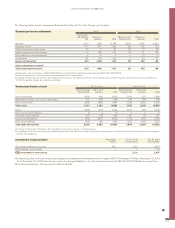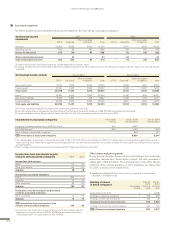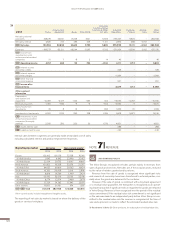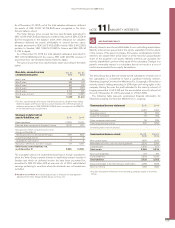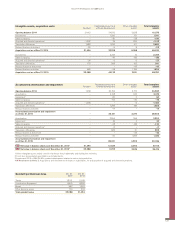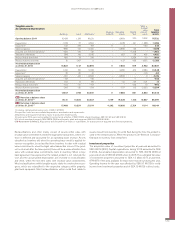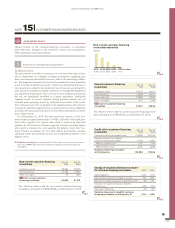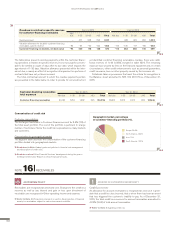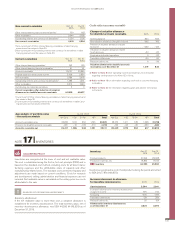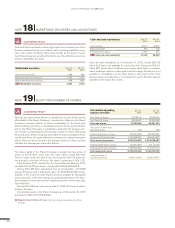Volvo 2015 Annual Report Download - page 132
Download and view the complete annual report
Please find page 132 of the 2015 Volvo annual report below. You can navigate through the pages in the report by either clicking on the pages listed below, or by using the keyword search tool below to find specific information within the annual report.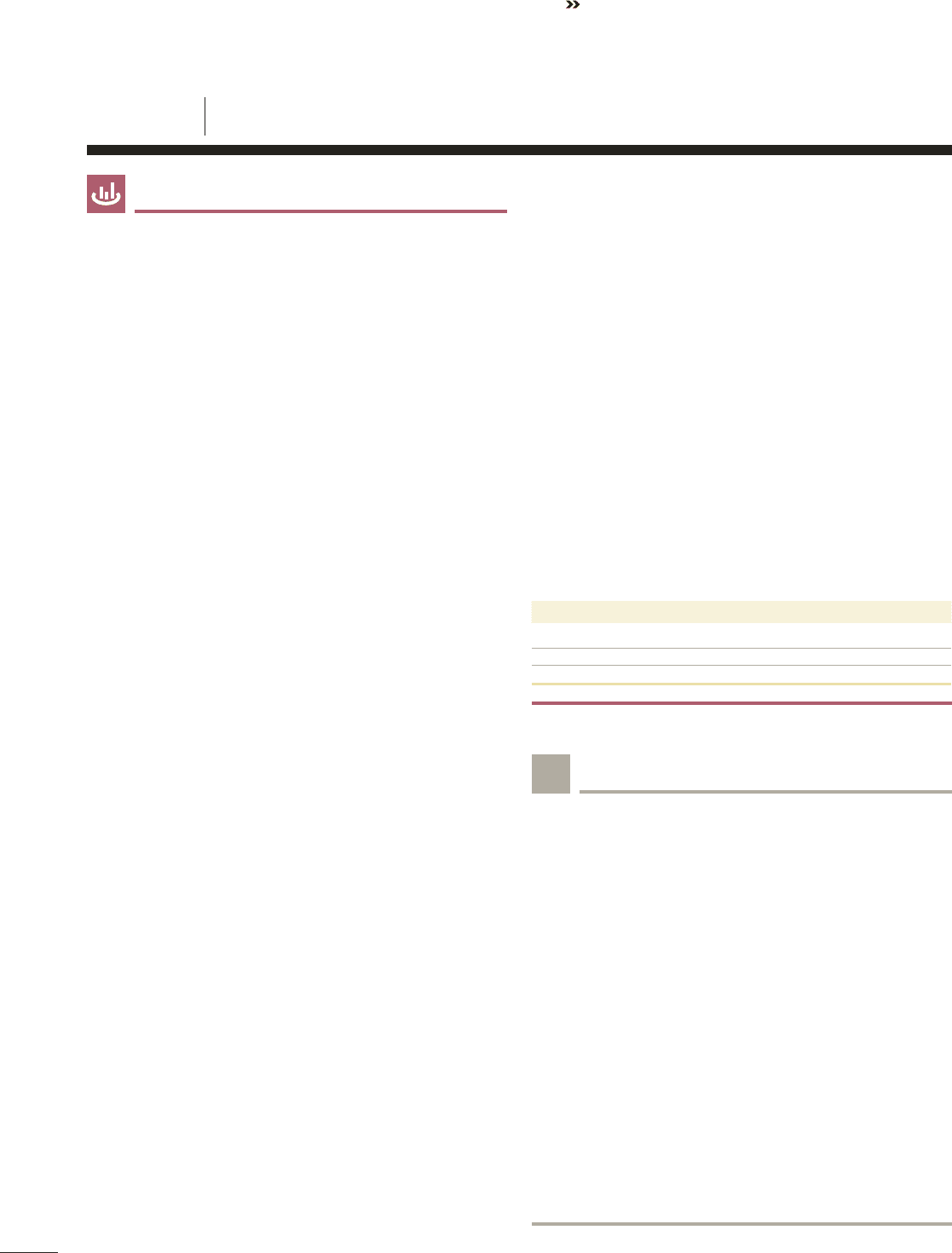
Volvo Group applies the cost method for recognition of intangible assets.
Borrowing costs are included in the cost of assets that are expected to
take more than twelve months to complete for their intended use or sale.
When participating in industrial projects in partnership with other com-
panies the Volvo Group in certain cases pays an entrance fee to partici-
pate. These entrance fees are capitalized as intangible assets.
Research and development expenses
Expenditures for the development of new products, production systems
and software are recognized as intangible assets if such expenditures,
with a high degree of certainty, will result in future financial benefits for
the company. The cost for such intangible assets is amortized over the
estimated useful life of the assets.
The rules require stringent criteria to be met for these development
expenditures to be recognized as assets. For example, it must be possible
to prove the technical functionality of a new product or software prior to
its development being recognized as an asset. In normal cases, this means
that expenditures are capitalized only during the industrialization phase of
a product development project. Other research and development expenses
are recognized in the income statement as incurred.
The Volvo Group has developed a process for conducting product devel-
opment projects named the DVP Project Handbook (DVP-PH). The
DVP-PH has six phases focused on separate parts of the project. Every
phase starts and ends with a reconciliation point, known as a gate, for
which the criteria must be met for the project’s decision-making commit-
tee to open the gate and allow the project to progress to the next phase.
During the industrialization phase, the industrial system is prepared for
serial production and the product is launched.
Goodwill
Goodwill is recognized as an intangible asset with indefinite useful life.
For non-depreciable assets such as goodwill, impairment tests are per-
formed annually, as well as if there are indications of impairments during
the year, by calculating the asset’s recovery value. If the calculated recov-
ery value is less than the carrying value, the asset is written down to its
recovery value.
The Volvo Group’s valuation model is based on a discounted cash-flow
model, with a forecast period of four years. Valuation is performed on
cash-generating units, identified as the Volvo Group’s business areas.
Each business area is fully integrated ensuring maximum synergy, hence
no independent cash-flows exists on a lower level.
Goodwill is allocated to these cash-generating units based on expected
future benefit from the combination. The valuation is based on a business
plan which is an integral part of the Volvo Group’s financial planning pro-
cess and represents management’s best estimate of the development of
the Group’s operations. Assumption of 2% (2) long-term market growth
beyond the forecast period and the Group’s expected performance in this
environment is a basis for the valuation. In the model, the Volvo Group is
expected to maintain stable capital efficiency over time. Other parameters
considered in the calculation are operating income, mix of products and
services, expenses and level of capital expenditures. Measurements are
based on nominal values and applies a general rate of inflation applicable
for the main markets where the Volvo Group operates. The Volvo Group
uses a discounting factor measured at 12% (12) before tax for 2015.
In 2015, the value of Volvo Group’s operations exceeded the carrying
amount of goodwill for all business areas, thus no impairment was recog-
nized. The Volvo Group has also tested whether a negative adjustment of
one percentage point to the aforementioned parameters would result in
impairment for any goodwill value however none of the business areas
would be impaired as a result of this test. The operating parameters applied
in the valuation are based on management’s strategy and could indicate
higher value than historical performance for individual Business Areas.
Furthermore the Volvo Group is operating in a cyclical industry where
performance could vary over time.
The surplus values differ between the business areas and are to a
varying degree sensitive to changes in the assumptions described above.
Therefore, the Volvo Group continuously follows the performance of the
business areas whose surplus value is dependent on the fulfillment of the
Volvo Group’s assessments. Instability in the recovery of the market and
volatility in interest and currency rates may lead to indications of a need for
impairment. The most important factors for the future operations of the
Volvo Group are described in the Volvo Group business area section, as
well as in the Risk management section.
Amortization and impairment
Amortization is made on a straight-line basis based on the cost of the
assets, adjusted in appropriate cases by impairments, and estimated use-
ful lives. Amortization is recognized in the respective function to which it
belongs, meaning that amortization of product development is part of the
research and development expenses in the income statement. Impair-
ment tests for amortizable assets are performed if there are indications of
impairment at the balance sheet date.
Amortization periods
Trademarks 20 years
Distribution networks 10 years
Product and software development 3 to 8 years
ACCOUNTING POLICY
Impairment of goodwill and other intangible assets
Intangible assets other than goodwill are amortized and depreciated over
their useful lives. Useful lives are based on estimates of the period in which
the assets will generate revenue. If, at the date of the financial statements,
any indication exists that an intangible non-current asset has been impaired,
the recoverable amount of the asset is calculated. The recoverable amount
is the higher of the asset’s net selling price and its value in use, estimated
with reference to management’s projections of future cash flows. If the recov-
erable amount of the asset is less than the carrying amount, an impairment
is recognized and the carrying amount of the asset is reduced to the
recoverable amount. Determination of the recoverable amount is based
upon management’s projections of future cash flows, which are generally
based on internal business plans or forecasts. While management believes
that estimates of future cash flows are reasonable, different assumptions
regarding such cash flows could materially affect valuations. The need for
impairment of goodwill is determined on an annual basis, or more fre-
quently if re quired through calculation of the value of the asset. Such an
impairment review will require management to determine the fair value of
the Volvo Group’s cash generating units, on the basis of projected cash
flows and internal business plans and forecasts. Surplus values differ
between the business areas and they are, to a varying degree, sensitive to
changes in assumptions and the business environment. The Volvo Group
has performed similar impairment reviews since 2002. No need for
impairment losses was required for the period 2002 until 2015.
SOURCES OF ESTIMATION UNCERTAINTY
!
NOTE 12 INTANGIBLE ASSETS
130
GROUP PERFORMANCE 2015 NOTES





